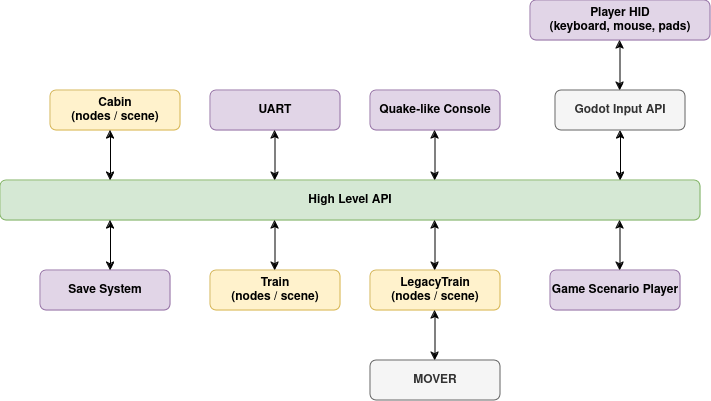Overall Architecture
- Godot Engine as the core of the project: Rendering, Multiplayer, Sound, Assets Pipeline, Utilities, Node system, Resources handling, Scene system, Input system, GDExtension as programming interface
- High-Level API for two-way communication between all high-level components and external systems
- Godot Nodes interface for internal communication (inside a high-level components)
Diagrams
Overall architecture

Communication example diagram

High-Level Components
High-Level Components should be identified as a complete and standalone objects in the game, which encapsulates it’s behavior and rendering. They should work just by adding them to the scene.
Examples of High-Level Components in the game:
- train vehicle
- complete cabin for a vehicle
- car
- building or element of the railway infrastructure (i.e. semaphore)
- Quake-like Console
- game’s scenario system
- UART communication system
Communication between game objects
The communication between High-Level Components (a game objects) must be implemented through High-Level API like TrainSystem, CabinSystem.
The communication is based on commands identified by unique string names. Commands are handled by High-Level API dispatchers like TrainSystem, where every vehicle or it’s element can register own commands and handlers. Every game object can handle own subset of all commands, which can be inspected at runtime. Adding and removing commands is also possible at runtime, because commands are dynamic.
For example, to enable battery in train1 vehicle, you need to send a command like this:
TrainSystem.send_command("train1", "battery", true)
Communication is asynchronous, because command execution may take the time (i.e. some systems must spin up). To check if the command was executed successfully, you must inspect the vehicle state:
TrainSystem.get_train_state("train1").get("battery_enabled")
NOTE In the future some feedback may be exposed through High-Level API signals
Internal communication
High-Level Components are usually built from many sub-components, which will handle a subset of a logic or rendering. The communication between these components is private, should be fastest as possible and straightforward. Because HLC (High-Level Component) know it’s internal structure, it can communicate with subcompones using direct method calls, accessing properties, signals.
Because there is no reasons to use High-Level APIs for internal communication, nodes usually have public interface by plain methods and properties:
extends TrainPart
var internal_state: bool = false
func operate_something(new_state:bool):
# some logic here
internal_state = new_state
But part of these methos can be also bound as command handlers for High-Level API:
extends TrainPart
var internal_state: bool = false
func _enter_tree():
register_command("operate_custom_part", self.operate_something)
func _exit_tree():
unregister_command("operate_custom_part", self.operate_something)
func operate_something(new_state:bool):
# some logic here
internal_state = new_state
Assume that there is a custom train composed like this, which has name
set to example_train.
+ TrainController
+-- TrainPart (with attached script as above)
Because TrainController “knows” the structure, it’s script can communicate
with TrainPart directly:
extends TrainController
func _process(delta):
if something:
$TrainPart.operate_something(true)
But any other game objects (HLCs) should call operate_something()
through CommandsAPI:
func _process(delta):
if something:
TrainSystem.send_command(
"example_train", "operate_custom_part", true)
This approach hides internal structure of the vehicle and creates a stable interface between game components.